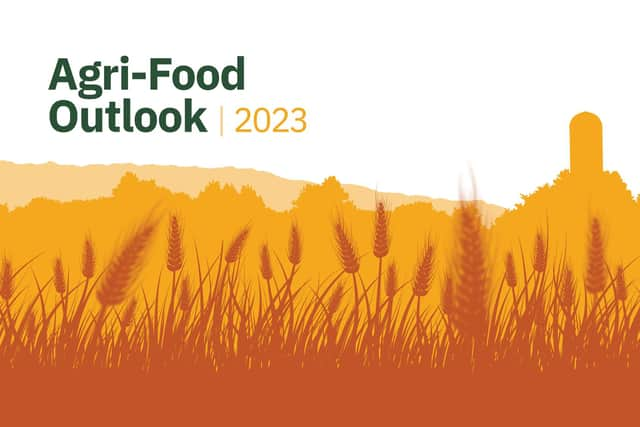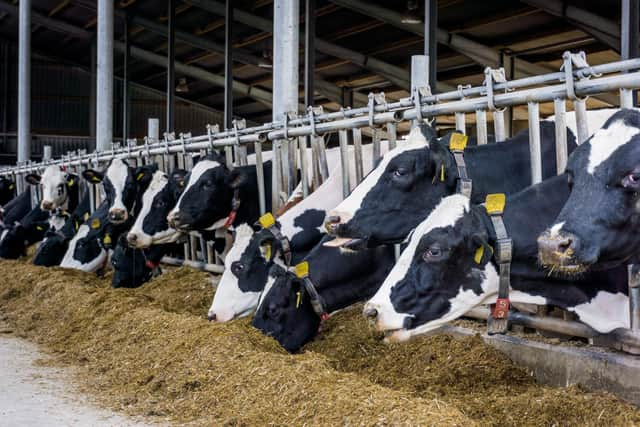Alltech publishes its 2023 Agri-Food Outlook survey
and live on Freeview channel 276
The report specifically identifies those technologies that are making a big impact within the industry, ongoing sustainability efforts and opportunities for growth.
Despite significant macroeconomic challenges that affected the entire supply chain, global feed production remained steady in 2022 at 1.266 billion metric tons (BMT) in 2022, a decrease of less than one-half of one percent (0.42%) from 2021's estimates.
Advertisement
Advertisement
The Agri-Food Outlook survey includes data from 142 countries and more than 28,000 feed mills.


Europe bore the brunt of the impact, including significant disease challenges, severe weather and the impacts of the invasion of Ukraine.
The global COVID-19 pandemic has had major impacts on the agri-food sector, contributing to supply chain challenges and accelerating the adoption of new technology and environmental sustainability practices.
The top 10 feed-producing countries over the past year were China (260.739 million metric tons [MMT]), the U.S. (240.403 MMT), Brazil (81.948 MMT), India (43.360 MMT), Mexico (40.138 MMT), Russia (34.147 MMT), Spain (31.234 MMT), Vietnam (26.720 MMT), Argentina (25.736 MMT) and Germany (24.396 MMT).
Advertisement
Advertisement
Together, the top 10 countries produced 64% of the world's feed production, and half of the world's global feed consumption is concentrated in four countries: China, the U.S., Brazil and India.


Vietnam experienced a great recovery in terms of its feed tonnage in 2022, entering the top 10 ahead of Argentina and Germany and crowding out Turkey, which reported reduced feed tonnage.
Russia overtook Spain, where there was a significant reduction in feed production.
Key observations from the survey:
Feed production increased in several regions, including Latin America (1.6%), North America (0.88%) and Oceania (0.32%), while Europe decreased by 4.67%, Africa by 3.86% and the Asia-Pacific region also dropped 0.51%.
Advertisement
Advertisement
Globally, increases in feed tonnage were reported in the aquaculture, broiler, layer and pet food sectors, while decreases were reported in the beef, dairy and pig sectors.
Although it experienced a narrow reduction in feed production, China remains the largest feed-producing country in the world, followed by the United States and Brazil.
Notable species results:
The poultry sector experienced increases in both layer and broiler feed production.
Avian influenza, other diseases and the high costs of raw materials affected the layer sector in many markets, especially in Asia, Europe and Africa.
Advertisement
Advertisement
On the other hand, growth in the sector was boosted due to bigger challenges in other sectors that led to increased demand for eggs. Overall, layer-sector feed production increased by 0.31%.
While the overall tonnage in the broiler sector increased by 1.27%, there were significant differences from country to country.
Overall, feed production growth in the broiler sector was reported mainly from the Middle East, North America and Latin America.
Pig feed production was down globally in 2022 by almost 3%. ASF and high feed prices depressed pig production in many countries.
Advertisement
Advertisement
However, in Vietnam, China, South Africa, Brazil and Mexico, better pork prices and other market conditions led to growth in the sector.
Dairy feed tonnage decreased by 1.32%, mainly due to the high cost of feed combined with low milk prices, which caused farmers to reduce their numbers of cows and/or rely more on non-commercial feed sources.
Some exceptions included Ireland, where drought caused farmers to rely more on commercial feeds, and New Zealand, where milk prices were higher.
Beef feed production decreased slightly by 0.34% globally.
The downward trend continued in Europe, but increases were seen in almost all other regions.
Advertisement
Advertisement
In Australia, the reduction in feed tonnage was a result of plentiful grass and not a reflection of any changes in the demand for beef.
The aquaculture sector experienced a total global feed production growth of 2.7%.
The Top 5 aquaculture feed countries are China, Vietnam, India, Norway and Indonesia. Significant increases were reported in China, Brazil, Ecuador, the Philippines and the U.S. Aquaculture feed production was one of a few sectors that saw growth in Europe.
Regional results:
North America reported an increase of 0.88% (2.272 MMT) and the U.S. remained the second-largest feed-producing country globally, behind China. Growth was reported in the broiler, beef and pet food sectors.
Advertisement
Advertisement
Latin America experienced growth of 1.6% (3.066 MMT), and Brazil remained the leader in feed production for the region and ranked third overall globally. Most of the growth was reported by Mexico, Brazil and Chile.
Europe saw the largest decrease in feed production of 4.67% (-12.882 MMT) in its feed production due to issues that include the invasion in Ukraine and the spread of animal diseases, such as African swine fever (ASF) and avian Influenza (AI).
Asia-Pacific remained flat as decreases reported in China, Pakistan, Thailand and Malaysia were offset by increases in Vietnam, the Philippines, Mongolia and South Korea. The region is home to several of the top 10 feed-producing countries, including China, India and Vietnam.
Africa experienced a decrease of 3.86% in feed tonnage (-1.718 MMT), mainly because of reductions reported in Egypt, Morocco, Kenya and Nigeria. South Africa, on the other hand, saw an increase of more than 2%, and Namibia also reported higher feed tonnage in 2022.
Advertisement
Advertisement
The Middle East region is up significantly at 24.7% (6.301 MMT), as a result of more accurate reporting and efforts by the Saudi Arabian government to increase broiler production as part of its Vision 2030 plan.
Oceania was flat, with a small reduction reported by Australia that was offset by a slight increase reported by New Zealand.
Alltech works together with feed mills and industry and government entities around the world to compile data and insights to provide an assessment of feed production each year.
Compound feed production and prices were collected by Alltech's global sales team and in partnership with local feed associations in the last quarter of 2022.
Advertisement
Advertisement
AHDB publishes 2022/23 ‘Early Balance Sheets’ for wheat and barley in the UK
Meanwhile, the Agriculture and Horticulture Development Board (AHDB) has just published the 2022/23 Early Balance Sheets for wheat and barley, which give a first look at grain supply and demand in the UK for the season ahead.
Wheat
A larger crop in 2022, outweighs a rise in demand to lead to a substantial exportable surplus for 2022/23. Key watch points for this season includes bioethanol and animal feed demand with margins continuing to be squeezed for both respectively.
With larger carry-in stocks and production, outweighing a projected fall in imports this season, availability of wheat is expected to be 8% up on the year at 18.735Mt.
Advertisement
Advertisement
UK wheat production is currently estimated at 15.664 million tonnes, up 12% on the year, driven largely by higher than average yields.
With a larger domestic crop this year, and imports not pricing competitively, full season imports are expected to drop this season to 1.225 million tonnes, down 769 thousand tonnes, year-on-year.
Total usage of UK wheat this season is expected to increase by just over half a million tonnes to 15.224 million tonnes, driven mainly by increased demand from the bioethanol sector.
With Vivergo fuels coming back online earlier this calendar year and with maize not pricing that competitively, it is expected that wheat usage by the bioethanol sector will increase this season.
Advertisement
Advertisement
It is assumed for the purposes of these balance sheets that both bioethanol plants will remain in operation throughout the season.
However, with rising input costs and the prospect of cheaper imported ethanol, domestic bioethanol margins are being squeezed. As ever, bioethanol demand will remain a key watch point this season.
Usage of wheat in animal feed is also expected to increase slightly on the year.
Despite animal feed production projected to fall this year, driven largely by a drop in monogastric feed, the inclusion of wheat in rations is expected to be higher.
Advertisement
Advertisement
This is due to the sheer availability and relative price competitiveness of the grain this season.
Again, animal feed demand also remains a watch point with producer margins being ever squeezed by rising input costs.
The increase in wheat usage is not enough to outweigh the rise in availability which has led to a balance of 3.511 million tonnes: 31% up year on year.
With an operating stock requirement of 1.5 million tonnes, this leaves an exportable surplus of 2.01 million tonnes, more than double the amount in 2021/22.
Barley
Advertisement
Advertisement
The barley balance is expected to be heavier this season on the back of higher supplies and a reduction in demand. However, the balance remains below the previous five-year average.
Despite smaller carry-in stocks, the total availability of barley this season is expected to be 120 thousand tonnes higher than in 2021/22 at 8.229 million tonnes, due to a rise in production.
UK barley production is estimated at 7.19 million tonnes, 229 thousand tonnes up on the year.
The rise in output is due to higher than average yields outweighing a smaller planted area. As with wheat, barley production has been estimated by AHDB for the purposes of these balance sheets.
Advertisement
Advertisement
Despite a projected rise in usage by the brewing, malting and distilling sector (BMD), a fall in animal usage has led to total domestic consumption of barley to decline by 155 thousand tonnes on the year to 6.154 million tonnes.
Despite the increase in cost of living BMD usage of barley is expected to remain robust this year with increased distilling capacity available in Scotland this season too.
Demand for barley in animal feed is expected to fall on the year by 196 thousand tonnes. At the start of last season barley was being included heavily in rations, which was a lag from 2020/21 when there was ample supply of barley.
With a larger supply and lacklustre demand, the UK barley balance is projected to increase this year by 276 thousand tonnes to 2.075 million tonnes.
About Alltech:
Advertisement
Advertisement
In the 1970s, founder, Dr. Pearse Lyons, immigrated to the United States with a dream: to sustain the planet and all things living on it. As an Irish scientist, he saw an opportunity to apply his yeast fermentation expertise to animal nutrition challenges, and his dream became a reality when he founded Alltech in 1980 with just $10,000.
Today, a global team of more than 6,000 people around the world shares this vision of sustaining and nourishing the world’s plants, animals and people.
They deliver on this vision by improving plant, feed and food quality through nutrition and scientific innovation, particularly yeast-based technology. The Alltech team is fully committed to helping plants and animals achieve their full potential while supporting producers in greater efficiency, profitability and sustainability.
At Alltech they provide natural-based products and solutions to agronomic and horticultural challenges facing producers across the globe, addressing the production of citrus, silage and everything in between.
Through innovative study of nutrigenomics, their nutritional technologies help animals maximize the nutrients in their feed for optimal well-being and performance.